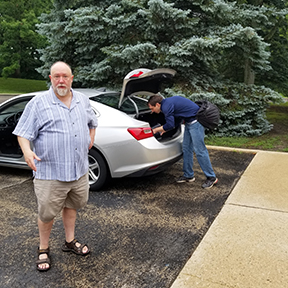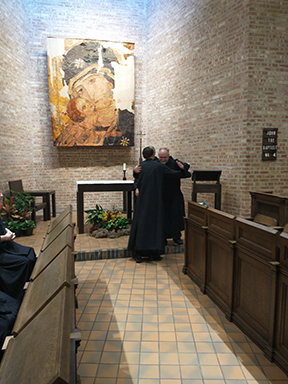Novitiates, Home and Away
- M. Mountin
- Jul 7
- 4 min read
Courtesy of Fr. James Flint's Weekly Newsletter
On Monday, June 23, Br. Aaron Minix was invested as a novice of our Abbey. The hope being that, with the help of God, he'll be able to make his first vows on the Solemnity of St. John the Baptist, June 24, 2026. During the third quarter of the twentieth century, many St. Procopius monks professed vows on this date, and since it worked well with the time for Br. Aaron's postulancy to come to an end, Prior Guy decided to time the hoped-for profession date this way.
Two days after the investiture, Br. Aaron headed south, for Belmont Abbey in North Carolina, where he will make his novitiate. This is the first time Belmont is training our novices, but for our first half-century and more, having novices formed in a place other than Lisle was standard practice for us. Well, let me qualify that: our clerical novices, those preparing, that is, for ordination to priesthood, were the ones sent away. The lay brothers of the community always had their novitiate at our Abbey. In the structure of Benedictine monasticism at the time, the brothers' role was assistance, usually some sort of manual labor, intended to free the priests of the community to carry out their ministry. Accordingly, their training was more of an apprenticeship than a regimen including classes. In our circumstances, moreover, the brothers often had Czech or Slovak as their first language; with most the other monasteries of our congregation, the first language would have been German, so there would have often been some difficulty with communication.
But to return to our practice of sending the clerical novices away for novitiate. At first, this was simply a continuation of what was necessarily the practice from our foundation in 1885 as a dependent priory of St. Vincent Archabbey. Naturally, our monks were trained at the mother house, and this continued even after we gained independence in 1887. There was a well-established novitiate structure already in place at the Archabbey, and making use of that meant one less thing for which the busy monks of St. Procopius had to allocate space and personnel. Was it a drawback that the novices would come to know another community than their own during this time of formation? Not really: most of those entering novitiate had attended the monks' small high school and college, which resulted in their being already well-known before joining the monastic community.
In the early twentieth century, for whatever reason, the place of novitiate was changed first to St. Benedict's Abbey in Kansas and then to St. John's Abbey in Minnesota. For many of the young men joining the community in those times, setting off for novitiate was a time of misery. Having spent, perhaps, four years in the Academy and two in the College, having made friends on campus and developed relationships with the monks of Lisle, being shipped to Kansas or Minnesota seemed more an exile than an excursion. Abbot Thomas told me once that he was SO fed up with being at St. John's that he was several times ready to leave novitiate. But the St. John's novice-master had a sense of a crisis brewing and would strategically grant a day off from the usual regimen.
By that time -- Abbot Thomas had his novitiate in 1935-1936 -- the members of St. John's Abbey were questioning why St. Procopius monks were still being trained at their monastery. The Lisle community was no longer new or small. From the viewpoint of St. Procopius, however, the very growth in Lisle was part of the problem. Every space in the Abbey building was occupied - where could a novitiate, somewhat apart from the community, be located? Abbot Valentine and then Abbot Procopius preferred the status quo of using St. John's to form our novices.
But by the end of the 1930s, two factors obliged a change. The novitiate "Class of 1937” included a priest in his forties, Fr. Chrysostom Tarasevitch, who though Latin Rite by birth was deeply interested in Byzantine Rite matters. Though in every way an admirable character, he was difficult to fit into a novitiate setting. When a second priest, Fr. Athanasius Reszec, a year or two later, wanted to join St. Procopius, the leadership at St. John's insisted that he be trained in Lisle, where he would be integrated better into the Church Unity work that Abbot Procopius was so strongly promoting.
The second push for a change originated in Lisle. The novitiate "Class of 1940” included, for the first time, two individuals of Irish extraction, Mark Bradley and George McGrath, who moreover had not attended the Abbey's schools. This meant that the community could not possibly be acquainted with them before their novitiate. Up to this point, most candidates had attended St. Procopius Academy and College for up to six years before applying to enter, and on a campus of a few hundred people everybody got to know everybody else. The well-respected teacher of classics, Fr. Clement Hrdlicka, forcefully argued to Abbot Procopius that, in these new circumstances, the novices needed to be trained at home. The point was conceded, and a clerical novitiate was at last established at Lisle.
Since then, only twice have candidates been sent elsewhere for novitiate, when during the 1960s there were years when only a single individual was applying. It was thought that having companions in the experience was preferable, and therefore in 1962 one applicant was sent to St. John's Abbey and in 1965 another to St. Benedict's.
Obviously, it's been a while since a Procopian monk was sent away for novitiate! Please keep Br. Aaron in your prayers as he prays, studies, and works with the Belmont community over the next twelve months.











